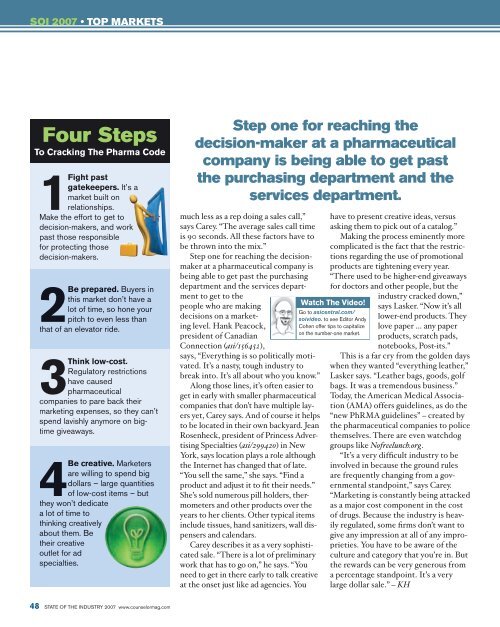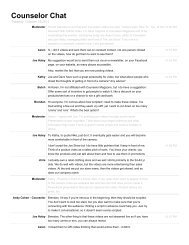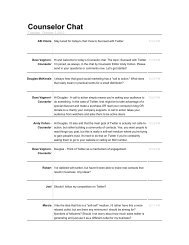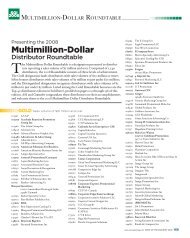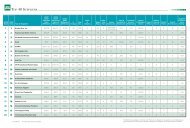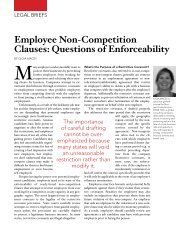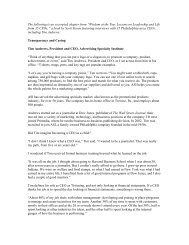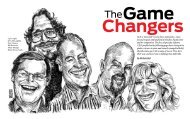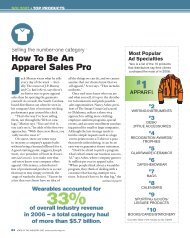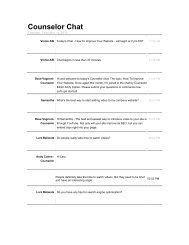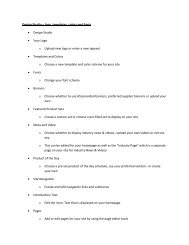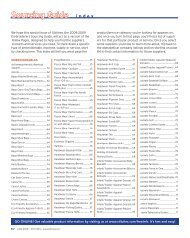Download PDF (7.94 MB) - Advertising Specialty Institute
Download PDF (7.94 MB) - Advertising Specialty Institute
Download PDF (7.94 MB) - Advertising Specialty Institute
Create successful ePaper yourself
Turn your PDF publications into a flip-book with our unique Google optimized e-Paper software.
SOI 2007 TOP MARKETS<br />
Four Steps<br />
To Cracking The Pharma Code<br />
1Fight past<br />
gatekeepers. It’s a<br />
market built on<br />
relationships.<br />
Make the effort to get to<br />
decision-makers, and work<br />
past those responsible<br />
for protecting those<br />
decision-makers.<br />
2Be prepared. Buyers in<br />
this market don’t have a<br />
lot of time, so hone your<br />
pitch to even less than<br />
that of an elevator ride.<br />
3Think low-cost.<br />
Regulatory restrictions<br />
have caused<br />
pharmaceutical<br />
companies to pare back their<br />
marketing expenses, so they can’t<br />
spend lavishly anymore on bigtime<br />
giveaways.<br />
4Be creative. Marketers<br />
are willing to spend big<br />
dollars – large quantities<br />
of low-cost items – but<br />
they won’t dedicate<br />
a lot of time to<br />
thinking creatively<br />
about them. Be<br />
their creative<br />
outlet for ad<br />
specialties.<br />
48 STATE OF THE INDUSTRY 2007 www.counselormag.com<br />
Step one for reaching the<br />
decision-maker at a pharmaceutical<br />
company is being able to get past<br />
the purchasing department and the<br />
services department.<br />
much less as a rep doing a sales call,”<br />
says Carey. “The average sales call time<br />
is 90 seconds. All these factors have to<br />
be thrown into the mix.”<br />
Step one for reaching the decisionmaker<br />
at a pharmaceutical company is<br />
being able to get past the purchasing<br />
department and the services depart-<br />
ment to get to the<br />
people who are making<br />
decisions on a marketing<br />
level. Hank Peacock,<br />
president of Canadian<br />
Connection ( (asi/156452),<br />
says, “Everything is so politically motivated.<br />
It’s a nasty, tough industry to<br />
break into. It’s all about who you know.”<br />
Along those lines, it’s often easier to<br />
get in early with smaller pharmaceutical<br />
companies that don’t have multiple layers<br />
yet, Carey says. And of course it helps<br />
to be located in their own backyard. Jean<br />
Rosenheck, president of Princess <strong>Advertising</strong><br />
Specialties ( (asi/299420)<br />
in New<br />
York, says location plays a role although<br />
the Internet has changed that of late.<br />
“You sell the same,” she says. “Find a<br />
product and adjust it to fi t their needs.”<br />
She’s sold numerous pill holders, thermometers<br />
and other products over the<br />
years to her clients. Other typical items<br />
include tissues, hand sanitizers, wall dispensers<br />
and calendars.<br />
Carey describes it as a very sophisticated<br />
sale. “There is a lot of preliminary<br />
work that has to go on,” he says. “You<br />
need to get in there early to talk creative<br />
at the onset just like ad agencies. You<br />
have to present creative ideas, versus<br />
asking them to pick out of a catalog.”<br />
Making the process eminently more<br />
complicated is the fact that the restrictions<br />
regarding the use of promotional<br />
products are tightening every year.<br />
“There used to be higher-end giveaways<br />
for doctors and other people, but the<br />
industry cracked down,”<br />
says Lasker. “Now it’s all<br />
lower-end products. They<br />
love paper … any paper<br />
products, scratch pads,<br />
notebooks, Post-its.”<br />
This is a far cry from the golden days<br />
when they wanted “everything leather,”<br />
Lasker says. “Leather bags, goods, golf<br />
bags. It was a tremendous business.”<br />
Today, the American Medical Association<br />
(AMA) offers guidelines, as do the<br />
“new PhRMA guidelines” – created by<br />
the pharmaceutical companies to police<br />
themselves. There are even watchdog<br />
groups like Nofreelunch.org.<br />
“It’s a very diffi cult industry to be<br />
involved in because the ground rules<br />
are frequently changing from a governmental<br />
standpoint,” says Carey.<br />
“Marketing is constantly being attacked<br />
as a major cost component in the cost<br />
of drugs. Because the industry is heavily<br />
regulated, some fi rms don’t want to<br />
give any impression at all of any improprieties.<br />
You have to be aware of the<br />
culture and category that you’re in. But<br />
the rewards can be very generous from<br />
a percentage standpoint. It’s a very<br />
large dollar sale.” – KH<br />
Watch The Video!<br />
Go to asicentral.com/<br />
soivideo. to see Editor Andy<br />
Cohen offer tips to capitalize<br />
on the number-one market.


